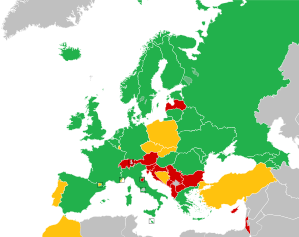Slovakia in the Eurovision Song Contest 2013
| Eurovision Song Contest 2013 | |
|---|---|
 |
|
| Dates | |
| Semi-final 1 | 14 May 2013 |
| Semi-final 2 | 16 May 2013 |
| Final | 18 May 2013 |
| Host | |
| Venue | Malmö Arena, Malmö, Sweden |
| Presenter(s) | Petra Mede |
| Directed by |
|
| Executive supervisor | Jon Ola Sand |
| Executive producer | Martin Österdahl |
| Host broadcaster | Sveriges Television (SVT) |
| Opening act |
|
| Interval act |
|
| Participants | |
| Number of entries | 39 |
| Debuting countries | None |
| Returning countries |
|
| Withdrawing countries | |
| Vote | |
| Voting system | Each country awarded 12, 10, 8–1 points to their 10 favourite songs. |
| Nul points | None |
| Winning song | |
| Eurovision Song Contest: Malmö 2013 | ||||
|---|---|---|---|---|
 |
||||
| Compilation album by Eurovision Song Contest | ||||
| Released | 29 April 2013 | |||
| Genre | Pop | |||
| Length |
|
|||
| Label | CMC, Universal | |||
| Eurovision Song Contest chronology | ||||
|
||||
The Eurovision Song Contest 2013 was the 58th edition of the annual Eurovision Song Contest. It took place in Malmö, Sweden, following Loreen's win at the 2012 contest in Baku, Azerbaijan with the song "Euphoria". It was the fifth time that Sweden had hosted the contest, the last time being in 2000. Sveriges Television (SVT) chose Malmö Arena as the venue following the consideration of several venues in Sweden. The host for the contest was Petra Mede. Thirty-nine countries participated, including Armenia, which was last represented in 2011. Bosnia and Herzegovina, Portugal, Slovakia and Turkey announced their withdrawal from the 2013 Contest.
The design of the contest was built around the theme "We Are One" – highlighting equality and unity of all the participating countries alongside the cultural diversity and influence of each participant. Compared to many of the previous contests in the history of Eurovision, rather than focusing on promoting its own country, Sweden chose to lay focus on the artists and their respective countries. The postcards presented before every song which have often been used to show the host country's nature, culture and social life, were changed to show the typical everyday life of each individual artist in their home countries scattered around Europe.
...
Wikipedia


